2024 Weekly Cyanobacteria Emails to Monitors
Click on the weekly report header to access the full report and photos.
Week 21 - LCC 2024 Cyano Monitor Email & Guidance for Future Reporting

Reports dwindled dramatically as we moved into November and head towards the 2024 season’s end in the middle of this month.
Dive in Deeper
In this email you’ll find monitoring results from 11/3 – 11/9/24, reporting resources, and photographs of leaf litter, a bloom-free Magog, murky water at Whitehall, all clear at Alburgh, and week 21 bloom-free close-ups.
Week 20 - LCC 2024 Cyano Monitor Email & Guidance for Future Reporting

Dive in Deeper
In this email you’ll find monitoring results from 10/27 – 11/2/24, reporting resources, and photographs of fall beauty at Blanchard Beach, a leafy scene, Eagle Bay solitude, wind and whitecaps at Leddy Beach, Lake Bomoseen in the clear, a crayfish in the shallows at Alburgh Dunes, murky Magog, beach bubbles, and week 20 bloom-free scenes.
Week 19 - LCC 2024 Cyano Monitor Email & Guidance for Future Reporting

Big thanks to all our dedicated monitors and a special shout out to the community science volunteers who are still reporting late in the season. These “shoulder season” observations help us gain a better understanding of water conditions. If you’re still able to get to shoreline areas, please keep reporting in.
Week 18 - LCC 2024 Cyano Monitor Email & Guidance for Future Reporting
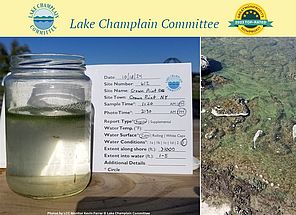
We have a far smaller cadre of community science volunteers checking monitoring sites this time of year so while we’re still receiving bloom reports our coverage both on Lake Champlain and inland waterways is greatly reduced. If you’re still venturing to shoreline areas or can, please keep reporting to help us get a better picture of autumn water conditions.
Week 17 - LCC 2024 Cyano Monitor Email & Guidance for Future Reporting
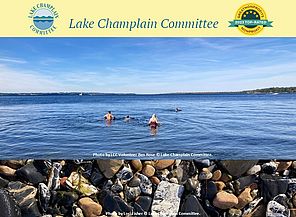
The cooler fall temperatures reduced the number of bloom sightings but we also have far fewer monitors reporting this late in the season so blooms could have been missed due to lack of coverage.
Dive in Deeper
In this email you’ll find monitoring results from 10/6 – 10/12/24, reporting resources, and photographs of cyanobacteria still showing up at Graveyard Point, turquoise cyanobacteria, stunning serenity, cyanobacteria specks, clear water at Newport Marina, Deep Bay still having blooms, a cloudy scene at Niquette Bay, autumn splendor, Pebble Beach beauty, week 17 cyanobacteria sightings, Inland Sea low alert, and a happy parting shot.
Week 16 - LCC 2024 Cyano Monitor Email & Guidance for Future Reporting
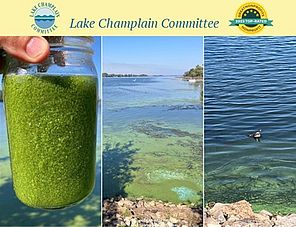
Over a third of the 91 monitoring reports received for Lake Champlain during week 16 chronicled blooms--only the Main Lake South and South Lake segments had no blooms reported. Lake Carmi and Shelburne Pond also had reports of blooms. Big thanks to all the community science volunteers and state and municipal partners assisting this year and another round of applause for those still filing weekly or daily reports! Your reports matter – please keep them coming.
Week 15 - LCC 2024 Cyano Monitor Email & Guidance for Future Reporting
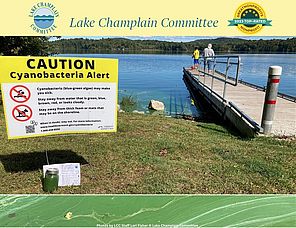
The number of reports received for Lake Champlain fell below 100 for the first time this year during week 15 and we only received 16 reports from inland VT waterways as more volunteers and state and municipal seasonal staff left their lakeside posts. Calm, dry, and relatively warm weather helped stimulate or sustain some significant blooms in Lake Champlain’s Main Lake North and Inland Sea and Malletts Bay had bloom activity as well.
Week 14 - LCC 2024 Cyano Monitor Email & Guidance for Future Reporting
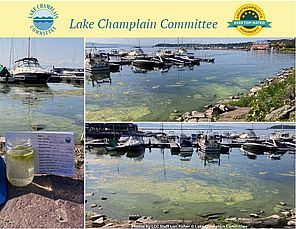
Blooms were observed daily during week 14 of monitoring and dominated the reports received on 9/15 and 9/20/24. A third of the reports over the seven-day period were of blooms reinforcing the importance of monitoring through much of fall and checking water conditions carefully before recreating.
Week 13 - LCC 2024 Cyano Monitor Email & Guidance for Future Reporting
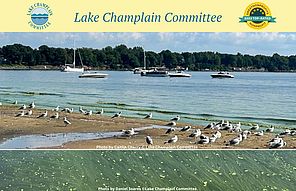
Hot weather at the end of week 13 helped fuel more blooms on Lake Champlain and inland waterways. When reviewing the stats for this week keep in mind that we have fewer monitors reporting this time of year, so coverage is less comprehensive. Case in point, we only received one report from St. Albans Bay but there were likely more blooms in that area during the week.
Week 12 - LCC 2024 Cyano Monitor Email & Guidance for Future Reporting
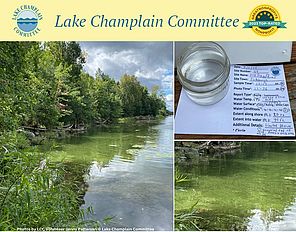
Reporting dropped off dramatically during week 12 as we had fewer blooms, and many municipal and state personnel who monitor beaches left seasonal posts. Reminder that while week 12 had a relatively low incidence of blooms compared to recent weeks it is still peak bloom season and cyanobacteria can show up in any waterway. (We are seeing a bloom response to the warmer temperatures in week 13.) Please keep your reports coming regardless of whether you witness cyanobacteria. Sincere thanks to all our monitors and community science volunteers. Your love of water, dedication to the program, and diligent reporting is deeply appreciated by the Lake Champlain Committee (LCC) and our partners.
Week 11 - LCC 2024 Cyano Monitor Email & Guidance for Future Reporting

Blooms were dominant at the beginning of week 11 in the northeast section of Lake Champlain on 8/26 with extensive ones reported in Missisquoi Bay, St. Albans Bay, Main Lake North, and the Inland Sea. Blooms were also observed at Lake Carmi, Lake Memphremagog, Shelburne Pond, and Ticklenaked Pond and unusual pink cyanobacteria was observed at Silver Lake in Barnard VT.
Week 10 - LCC 2024 Cyano Monitor Email & Guidance for Future Reporting
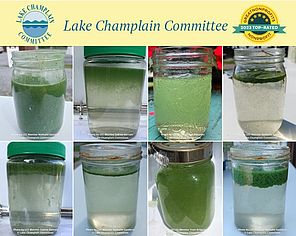
Week 10 was busy for the LCC cyanobacteria monitoring team as Lori announced her upcoming retirement (12/31/24), Alexa got married, Lindsey headed off to trek for a week in the wilds of Montana and Alberta, and Eileen wrapped up a big project on native aquatic plants. On the cyanobacteria beat, blooms dominated the scene in some Quebec portions of Lake Champlain’s Missisquoi Bay and parts of St. Albans Bay.
Week 9 - LCC 2024 Cyano Monitor Email & Guidance for Future Reporting
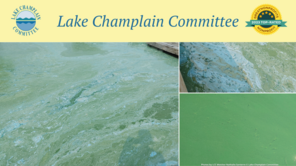
It was another week of highly variable conditions depending upon where you were. Monitors filed 240 reports during week 9 and 19% were of blooms. The majority came from northern sections of Lake Champlain, and some blooms persisted for days and continued into week 10. The daily reporting that is so important to chronicling the duration and extent of a bloom is time consuming and challenging – and witnessing cyanobacteria covering bays and shorelines of places you love tugs at your heart strings.
Week 8 - LCC 2024 Cyano Monitor Email & Guidance for Future Reporting
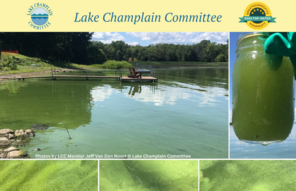
Some extensive and persistent blooms were experienced in northern sections of Lake Champlain and various inland waterways including the Poultney River during week 8 of monitoring. Deep thanks to you and all the dedicated monitors for your commitment to the program and hats off to everyone who filed daily reports through the duration of the blooms. We know it’s a lot of work but it’s valuable and greatly appreciated by the LCC team.
Week 7 - LCC 2024 Cyano Monitor Email & Guidance for Future Reporting

While most monitors reported generally safe conditions during their week 7 site rounds, those that did observe blooms often found them widespread. And blooms certainly weren’t restricted to Lake Champlain – VT inland waterways of Lake Carmi, Shadow Lake, and the Moore Reservoir all had significant blooms. In this email you’ll find details on weekly conditions, resources to assist your reporting, along with photographs of Gloeotrichia sp.; spinach smoothie look-alikes; bloom gloom at Lake Champlain sites at Venise-en-Québec QC, Philipsburg QC, Macomber Point in the Inland Sea VT, Niquette Bay VT; and inland lake VT sites at Lake Carmi, Shadow Lake, Shelburne Pond.
Week 6 - LCC 2024 Cyano Monitor Email & Guidance for Future Reporting

While many monitors reported bloom-free conditions during week 6 where cyanobacteria did show up it sometimes persisted for several days. In this email you’ll find details on weekly conditions, resources to assist your reporting, and photographs of week 6 bloom zooms, high alerts at Stephenson’s Point VT and Philipsburg QC, a low alert at Lake Carmi, khaki-colored blooms, clumps of blooms, Gloeotrichia sp. – a colonial cyanobacteria, tools of the trade, clear water scenes, and parting shots tracking a bloom.
Week 5 - LCC 2024 Cyano Monitor Email & Guidance for Future Reporting
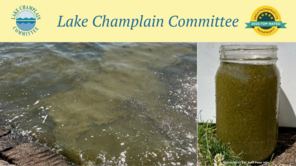
Thank you for weathering another week of IT challenges as the international tech program issue affected the cyanobacteria tracker and reporting forms and delayed our weekly email update. A special shout out of appreciation to Daniel Jarvis of the Vermont Agency of Digital Services for working diligently on a fix to bring the tracker back online swiftly. If you missed sending in your reports during the tracker glitch, please file them now so we can log your data into the system.
Week 4 - LCC 2024 Cyano Monitor Email & Guidance for Future Reporting
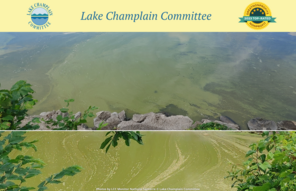
It was eerily familiar last week as floodwaters wreaked havoc on infrastructure, communities, and ecosystems, exactly a year after the historic July 2023 flooding. We hope you didn’t personally endure damage but know everyone in the watershed is affected as we witness the devastating effects of another high intensity storm. Some monitors have been unable to access their sites due to washed out roads and some sites are closed due to damage.
Week 3 - LCC 2024 Cyano Monitor Email & Guidance for Future Reporting
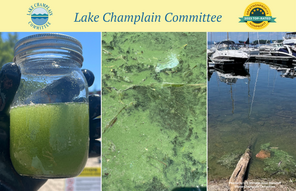
Hot weather during the 4th of July holiday week led to a burst of blooms and the tracker went down over the weekend due to problems with the State of VT server system making for a challenging week 3! Many monitors had to file their reports through LCC which then required us to manually enter everything into the state system once the tracker was back online. We’ve caught up with the backlog but phew!!
Week 2 - LCC 2024 Cyano Monitor Email & Guidance for Future Reporting
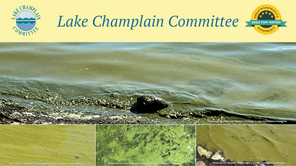
Thanks to everyone who has reported and a special shout out to monitors who file daily and/or assess conditions at multiple sites. All of your individual and collective efforts are greatly appreciated by the LCC team and our monitoring partners.
While we have a strong roster of community science volunteer monitors, we are missing coverage in some key Lake Champlain locations including St. Albans Bay, Missisquoi Bay, South Lake, and various New York shoreline access areas. We also would be delighted to add monitoring sites at any inland lake public access area currently not covered.
Week 1 - LCC 2024 Cyano Monitor Email & Guidance for Future Reporting
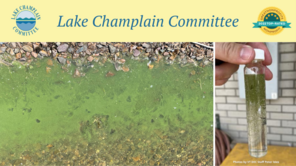
Thanks to everyone who reported during week 1 of the 2024 cyanobacteria monitoring season! Hundreds of reports flowed in and kept us hopping. It was wonderful to see monitors at our open house so we’re being spontaneous and hosting another one tomorrow on very short notice – Friday 6/28/24 from 10:00 AM until 4:30 PM at the LCC office in Burlington’s south end. Please read on for details of Week 1 monitoring results along with resources to guide your reporting.
